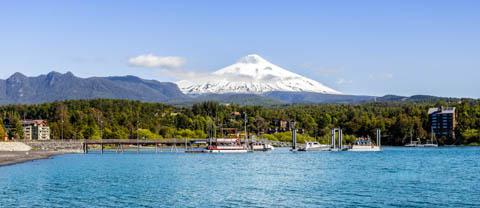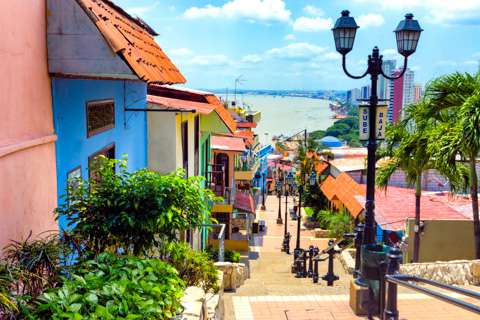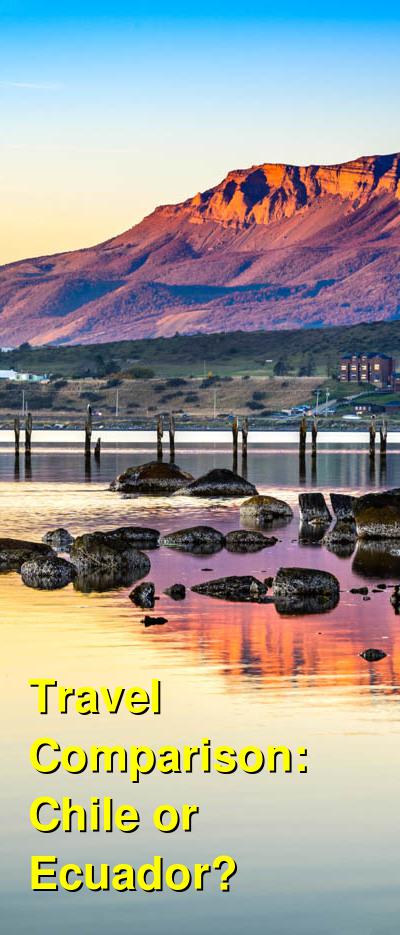Should you visit Chile or Ecuador?
Chile and Ecuador are both common travel destinations for visitors to South America. However, they can be quite different, not just in their overall travel costs. Ecuador has a warmer, more tropical climate with rain and cloud forests in the hills and mountains of the inland areas of the country. Chile is long and rugged, covering a huge stretch of the Andes Mountains. Here you'll find beaches along with ample room to hike in Patagonia.
The top three destinations in Chile include the Torres del Paine National Park in Patagonia for some raw and picturesque scenery and wildlife, The Lake District region, especially for water-sports lovers and Atacama for the desert, salt flat and stargazing.
Chile is a long and narrow strip of land that's almost entirely mountainous with some coastal plains. While there are a few airports within the Chile's Patagonian region, travel is mainly handled over land and by water. Therefore the most important question that you need to answer before you head this far south on the globe is how much time you have.
Ecuador is one of the smallest countries in South America but do not be fooled; there is plenty to see, do, and experience! Ecuador is one of the most biodiverse regions in the world. It boasts 50 ecosystems, from the Galapagos to tropical rainforests to forested valleys to the Andean mountains and with several hotspots that have been named UNESCO World Heritage Sites. Ecuador is a great destination because it offers so much in a territory that is about the same size as the state of Colorado. Ecuador is easy to explore, and a small setting will allow travelers to see numerous destinations without riding in a vehicle all day. Traveling from the Pacific Ocean to one of the highest mountains on earth, and then visiting the jungle can even be done in one day! Ecuador is all about adventure. Hiking, biking, kayaking, horseback riding, diving, swimming, rafting, trekking through the jungle, mountains or volcanoes and rewarding your hard work with a good dip in a hot spring or an hour or two on a tropical beach. And the great news is that there is no need to spend your time figuring out exchange rates because Ecuador has been using the U.S. Dollar as currency since 2000, when it retired the Sucre. With 530 miles of coastline, it's no surprise that Ecuador has some of the most beautiful beaches in South America. Coastal towns to visit include the popular Salinas and Puerto Lopez, Salango for snorkeling and scuba diving, and Atacames for the fantastic nightlife. Not to mention the Galapagos Islands. If you are seeking for some true adventure, travel to the Andes and the Cotopaxi National Park, where one of the highest active volcanoes in the world has erupted more than 50 times since 1738. Ecuador blends Spanish culture with African and European influences, and this vibrancy is reflected in the people and its cities. As Ecuador's capital, Quito is where you are heading for culture, stunning views, great nightlife especially karaoke bars, and local meals. And speaking of food, the country's cuisine is as diverse as its landscape. Hearty mountain fare and seafood make up Ecuador's national dishes, which include a citrusy ceviche, toasted corn snacks, a cheesy potato soup, pan-fried pork and chicken, goat stew and guinea pig. In city centers, visitors will find museums, theaters, thriving markets, festivals, and very welcoming people.
Which country is cheaper, Ecuador or Chile?
Should I visit Chile or Ecuador? This is a popular question for many travelers. By figuring out which country is more expensive, you'll understand where you'll get more bang for your buck. A week in Ecuador can cost you about $443 (per person), while a week in Chile may cost you around $734. These differences become even more noticable if you plan to spend a longer time in the country. 10 days, two weeks, or even one month of travel to Ecuador or Chile can really add to your travel budget.
Accommodation is often cheaper in Ecuador compared to Chile ($20 vs. $60). Budget travelers usually stay in less expensive hostels and guest houses, while nicer hotels often appeal to families and upscale travelers.
Compare hotel prices here: Chile Hotel Prices and Ecuador Hotel Prices.
Or, compare hostel and guesthouse prices between Ecuador and Chile to find the cheapest accommodation here: Ecuador hostels and Chile hostels.
When comparing food in Chile vs. Ecuador they are not just different in cuisine, but also in price. Meal and restaurant costs in Chile ($23) are often cheaper than Ecuador ($19).
When is the best time to visit Chile and Ecuador?
 Pucon, Chile
Pucon, Chile
The best time to visit Chile depends on the purpose of your trip. Go there from June to September if you plan to spend your days on the snow, preferably avoiding July and August if you do not want to be overcrowded on the slopes. If you want to catch the sun in chic beach resorts and party until the sun comes out, November to February is your time-slot.
However, if you are planning to hike through Patagonia and visit the natural wonders, then prioritize mid-seasons. Either go around September to November or from March to May. Both are low seasons, but the spring landscape, September to November, is the nicest of the two. If you do not handle the cold very well, avoid going to Patagonia before mid-October and after April. On the other hand if you love the snow, winter landscapes, skiing and travelling during low season with few tourists and lower prices, you should definitely visit Patagonia during end of autumn or beginning of spring. While you will get all the advantages of travelling during low season, you will also be able to enjoy a sunny weather, still quite cold but manageable. While a few activities (hikes, excursions) will begin to close (end of autumn) or still be closed (towards spring), you will definitely be able to do most of the essential activities and to fully enjoy some of them as you might find that you have a hiking path all to yourself! The differences in prices between low and high season are not tremendous but you will probably be able to save some money on deals with accommodation and a few other fees.
Many visitors describe Ecuador as the "Hidden Jewel of South America". This is because of the unmatched diversity in landscape, ecosystem and culture present in the country, but also because Ecuador enjoys mild spring-like weather conditions year-round with a gorgeous temperature of 65 degrees (F). Locals and travelers often describe Ecuador as the "Eternal Spring", which makes it an ideal place to visit any time of the year. Weather variations are usually the result of regional differences and micro-climates rather than clearly defined seasons. In between January and May is the coolest and wettest time period in Ecuador. Many people still choose to travel to Ecuador at this time because rainfall mostly presents itself in afternoon showers and the waters around the Galapagos Islands are at their warmest. The driest and warmest months in Ecuadorian mainland occur from June to September. Visitors can often enjoy clear blue Andean skies and warm sunshine. Fewer showers also make for more prolonged periods to enjoy bird-watching in the cloud-forests. This is also the peak time to visit neighboring Peru, so early planning is advisable. In the highlands, the 'four seasons in a day' phenomenon can happen at any time, so you should not limit your travel planning to this drier season. The months of October, November and December are a popular time to visit Ecuador, as the South American national holidays approach and the waters around the Galapagos become calmer again, so early booking is again advisable.
Why is Chile more expensive than Ecuador?
Foreigners often have a misconception about all of South America being cheap. This is not the case of Chile. Especially when coming from other nearby countries, Chilean prices will come quite as a shock due to the high cost of living in the country. Its political and economic stability means that it is one of the most expensive South American countries and Chile continues to boast one of the highest ratios of executive salary rates to cost of living.
Traveling between December and March means traveling in high season in Chile. Like in most developed countries, the locals also travel during high season, which means hotels and hostels are heavily booked in advance and prices rise, especially in popular destinations like the Lake District or Patagonia.
Ecuador has a fairly low cost of living. It is astonishingly diverse and interesting but it's also a relatively small and compact country, which reduces the need to spend on long-distance transportation the way you will in neighboring countries.
Activities are pretty cheap. For example, a round trip on the stunning Devil's Nose train will cost USD$30, hiking trips to volcanoes and mountains usually start at around USD$40 and in terms of accommodation there are ample cheap private rooms to be found in Ecuador, and often the price difference between a dorm bed and a basic private is minimal. The one thing that can really tip the scale is visiting the Galapagos Islands. However few tourists travel to Ecuador without visiting the Galapagos Islands, which on its own requires a budget of at least USD$1000 per person though probably a bit more.
What are the most expensive and cheapest cities and regions in Chile and Ecuador?
 Guayaquil, Ecuador
Guayaquil, Ecuador
In Chile, Southern Patagonia tends to be cheaper than the North. However, travelling through this large piece of land requires a certain budget and certain cities are surprisingly expensive. In the small towns of Patagonia, costs tend to be cheap due to competition. However, sometimes transportation can get pricey and the more frequently visited a destination by tourists, the higher the prices can get. The time of year and festivals can also dramatically affect cost.
Quito is a cosmopolitan city, where colonial architecture blends with modern life. It provides visitors with incomparable scenery surrounded by the breath taking Andes Mountains. On its colonial center, Quito offers narrow cobblestones streets, a maze maze of churches, and history and tradition in every corner. Cuenca is Ecuador's third-largest city. It hustles and bustles, but with a certain provincial charm. This prosperous and beautiful highland city has retained much of its colonial splendor, and, like Quito's, its city center has been declared a UNESCO World Heritage Site. Oddly enough, Quito and Cuenca costs more than the capital these days because the average income is higher and a lot of wealthy Ecuadorians have moved back from abroad and settled there for a more mellow life. Get beyond these two cities and Guayaquil, and you will be sure that living expenses are even less. Riobamba, Vilcabamba, Cotacachi, or other towns in the Andes are definitely cheaper.
How you can save money when visiting Chile and Ecuador?
Cooking in your hostel's kitchen is one of the best ways to keep your travel costs down, to meet fellow travellers and supermarkets are also great places to go to see what the local people eat. Another good self-cook method is to make your own picnic for lunch, especially if you plan to spend the day outdoors, perhaps trekking in one of the many national parks.
Don't fly domestically unless you have to. Unless you are in a rush, consider taking the bus. While not very common in the north of Chile, if you're in Patagonia, you'll see many locals and tourists alike hitchhiking, as long-distance buses in that part of the country can be on the expensive side and infrequent. An inexpensive way to get around and also out of the cities is to rent bicycles from your hostel or rental shops, usually for no more than USD$10 a day. Hiking is free, and throughout the country you'll find plenty of opportunities to enjoy this and other free outdoor activities since this area is blessed with many city parks and nature reserves where you can spend the day wandering around and relaxing. As you start to travel south to Patagonia, accommodation costs get higher. Hostels are often USD$17 USD or more a night as opposed to as cheap as USD$6 a night in Buenos Aires for example. Look for camping opportunities as often as possible. When you aren't in the national parks, many hostels will let you pitch your tent for a small fee.
To save money in Ecuador, look into staying in Hospedajes, a very affordable accommodation option. These family-run guesthouses are all over the country and have rooms for just a few dollars per night. Eat and food shops at the markets. You can find meals and kilos of fruits for just a few dollars, making this the best way to eat cheaply in the country. Many restaurants have almuerzos, cheap lunches from a set menu, which are usually just a couple of dollars and even include a drink! Try to carry as much small change as you can as you will have trouble changing bigger notes than USD$20, especially in small towns. A good money saving tip is to book last minute tours. By booking your Galapagos Island cruise in Quito last minute, you can save up to 40% off the expensive cost of the trip. If you're flexible in when you go and can wait around for a spot to open, the cheapest option is also to just fly there and see what is around. If you want to make your trip even cheaper, find free accommodation and a chance to make a local friend on Couchsurfing.


 Budget Your Trip is all about finding out how much everything costs so that you can travel cheaper and longer. Created by avid travelers Laurie and Bryan, our goal is to help you plan your next trip on the right budget. With average daily travel costs that are calculated from the budgets of real travelers, plus an analysis of hotel and tour prices, you can find out how much money you need to plan your next adventure. We also have plenty of travel advice, accommodation reviews, and activity suggestions.
Budget Your Trip is all about finding out how much everything costs so that you can travel cheaper and longer. Created by avid travelers Laurie and Bryan, our goal is to help you plan your next trip on the right budget. With average daily travel costs that are calculated from the budgets of real travelers, plus an analysis of hotel and tour prices, you can find out how much money you need to plan your next adventure. We also have plenty of travel advice, accommodation reviews, and activity suggestions.
